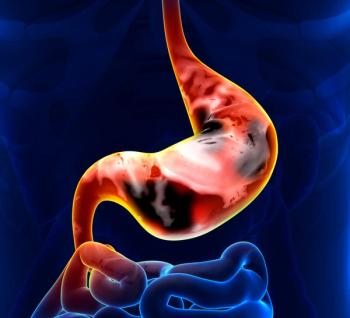
Oncology NEWS International
- Oncology NEWS International Vol 15 No 9
- Volume 15
- Issue 9
Study Questions the Need for Maintenance Therapy in Metastatic Colorectal Cancer
For metastatic colorectal cancer, the benefits of maintenance therapy with 5-FU/leucovorin appear questionable, according to results of the OPTIMOX2 study
ATLANTAFor metastatic colorectal cancer, the benefits of maintenance therapy with 5-FU/leucovorin appear questionable, according to results of the OPTIMOX2 study, presented by Frederique Maindrault-Goebel, MD, of Saint Antoine Hospital, Paris, France, at the American Society of Clinical Oncology 42nd Annual Meeting (abstract 3504). In the randomized phase II trial, maintenance therapy with 5-FU/leucovorin prolonged progression-free survival but did not improve duration of disease control, as compared to stopping chemotherapy after FOLFOX7, the Groupe Cooperateur Multidisciplinaire en Oncologie investigators showed.
OPTIMOX2 randomized 202 patients with metastatic colorectal cancer to either chemotherapy with modified FOLFOX7 followed by a chemotherapy-free interval, then a reintroduction of FOLFOX7 as needed (the experimental arm), or to chemotherapy followed by maintenance therapy and reintroduction of FOLFOX7 in a "stop and go" strategy as used in the previous OPTIMOX1 trial. OPTIMOX1 found the oxaliplatin "stop and go" strategy to be as active as continuous treatment, but less toxic, Dr. Maindrault-Goebel said.
The modified FOLFOX7 regimen had a lower oxaliplatin dose than that used in OPTIMOX1 (100 vs 130 mg/m2) and a slightly higher dose of continuous infusion 5-FU (3,000 vs 2,400 mg/m2).
Both arms received six cycles of modified FOLFOX7 (oxaliplatin 100 mg/m2 and leucovorin 400 mg/m2 on day 1, then 5-FU 3,000 mg/m2 as a 46-hour continuous infusion, every 2 weeks).
The OPTIMOX1 strategy arm then received maintenance with a simplified regimen of leucovorin 400 mg/m2, followed by a 5-FU 400 mg/m2 bolus and 5-FU 3,000 mg/m2 46-hour infusion. Upon "baseline progression," patients in both arms received modified FOLFOX7 for six more cycles. Baseline progression was defined as regrowth of the tumor to its baseline size. At this point, or when patients became symptomatic, FOLFOX7 was reintroduced in both arms.
Study Results
The response rates to both regimens were equal, at 61%, with each arm achieving a 3% complete response rate. After a median follow-up of 70 weeks, however, progression-free survival was significantly longer in the OPTIMOX1 maintenance arm (8.7 months vs 6.9 months, P = .009). Similarly, more OPTIMOX1 patients remained progression free more than 6 and 12 months later.
Among patients who required a reintroduction of chemotherapy, the response rates were higher in the experimental chemotherapy-free-interval arm (31%), compared with the maintenance arm (13%), with stable disease rates of 24% and 43%, respectively. The higher response rate might be attributed to a lack of resistance to 5-FU in patients who did not have maintenance chemotherapy, she suggested. In this patient subset, median progression-free survival after treatment reintroduction was similar between the arms, at 3.7 months for the experimental arm and 4.1 months for the maintenance arm.
Median chemotherapy-free interval was higher for patients who responded (5.1 vs 3.9 months for stable disease patients), and for patients with good vs adverse prognostic factors.
Importantly, the "duration of disease control" was not significantly different between arms. Duration of disease control was the combined time for which patients were progression free following the initial treatment and also following reintroduction (see Figure on page 36). This was longer in the maintenance group12.9 months vs 11.7 monthsbut was not significant (P = .41).
Sensory neuropathy was minimal during the first six cycles of each regimen, and remained uncommon 2 months later, when 3.2% of the maintenance arm and 4.4% of the experimental arm had developed grade 3 neuropathy.
Dr. Maindrault-Goebel explained that the lower incidence of neuropathy could be the result of stopping treatment after the sixth cycle and also using a lower dose of oxaliplatin in the modified FOLFOX7 regimen. After FOLFOX7 was reintroduced, grade 3 neuropathy was observed in 8.7% of the maintenance ther-apy patients and in 13.5% of the experimental group.
In her conclusion, Dr. Maindrault-Goebel stated, "Maintenance therapy improves progression-free survival but duration of disease control is the same with or without maintenance. It is too early to know the impact of a chemotherapy-free interval on survival. . . . Based on these results we believe we can safely stop modified FOLFOX7 after only six cycles, especially in patients with a response or stabilization and with no adverse prognostic factors."
Articles in this issue
over 19 years ago
Exjade Gains Approval in EUover 19 years ago
President's Cancer Panel Assesses Progress in Two Areasover 19 years ago
Cognitive Rx Reduces Depression in Breast Ca Ptsover 19 years ago
Nurses Develop Evidence-Based Guidelines for Mucositisover 19 years ago
Anastrozole Therapy for Breast Cancer Affects Bone Healthover 19 years ago
Is Demand for Trial Subjects Outpacing Supply?over 19 years ago
Postchemo Disappearance of Liver Mets Doesn't Mean Cureover 19 years ago
Aromasin-Related Bone Loss Affected by Vitamin D Levelsover 19 years ago
Melanoma Mets Regress After Gene TherapyNewsletter
Stay up to date on recent advances in the multidisciplinary approach to cancer.

















































































